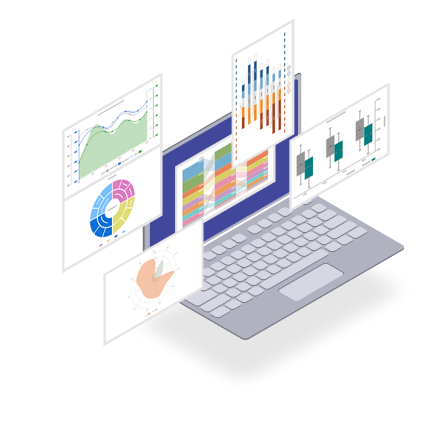Contents
Top U.S. companies every Indian investor should know
7 minutes read
28 March 2025

The S&P 500, an index tracking 500 of the largest publicly traded companies in the U.S., is often seen as a reliable indicator of market health. In 2025, the index has continued to perform strongly, with many of its top companies experiencing impressive growth. Did you know that just 25 companies make up a significant portion of the S&P 500’s total market value? Understanding these top stocks is key for any investor looking to gain insights into the broader U.S. economy and make informed decisions. This blog will break down these top 25 S&P 500 stocks, highlighting why they matter, how they shape the index, and what you need to know about investing in them.
Understanding the S&P 500
The S&P 500 index is considered one of the most important benchmarks for the performance of the U.S. stock market. Comprising 500 of the largest companies, it reflects the overall health of the economy. To be included in the S&P 500, companies must meet certain criteria: they must be based in the U.S., have a significant market cap, maintain profitability, and display liquidity with active trading volume.
Market Cap Weighting is a key factor in the S&P 500's construction. The index is weighted by market capitalization, meaning that companies with larger market caps have a greater influence on the index's performance. For example, Apple, Microsoft, and Amazon dominate the index due to their massive market caps.
The S&P 500 is reconstituted annually in June to ensure that only companies meeting the current criteria are included. This keeps the index fresh and aligned with the current market environment.
Sector breakdown of the S&P 500
The S&P 500 is made up of various sectors, each contributing differently to the overall performance of the index. The top sectors include:
- Information technology: Dominates the index, with giants like Apple, Microsoft, and Nvidia.
- Financials: Includes major banks and financial services firms like JPMorgan Chase and Bank of America.
- Health care: Represents companies like UnitedHealth Group and Johnson & Johnson, critical to the U.S. economy’s health sector.
- Consumer discretionary: Companies like Amazon and Tesla drive consumer spending and innovation.
On the flip side, sectors like Energy, Utilities, and Real Estate hold much smaller weightings in the index. For example, Energy stocks make up less than 3% of the S&P 500’s market cap.
Visual Aid: Consider adding a pie chart showing the weighting of major sectors for clarity.
The top companies
As of the most recent data, the top 25 S&P 500 companies play a crucial role in the overall performance of the index. Here's a quick look at the top 10 companies by weight:
1. Apple (AAPL)
- Sector: Information Technology
- Market cap: $2.7 Trillion (approx.)
- Weight in S&P 500: 7%
- Why it matters: Apple is not just the largest company in the S&P 500, but it’s also a global powerhouse in consumer electronics. Its flagship products—like the iPhone, MacBook, iPad, and Apple Watch—are a major part of its revenue, alongside growing services like the App Store, iCloud, and Apple Music. Apple’s consistent innovation and loyal customer base have kept it at the forefront of the tech world. Given its massive market cap, Apple's performance is crucial in driving the S&P 500’s movement—if Apple falters, the index likely follows.
2. Microsoft (MSFT)
- Sector: Information Technology
- Market cap: $2.4 Trillion (approx.)
- Weight in S&P 500: 6.5%
- Why it matters: Microsoft, the software giant behind Windows, Office, and Azure, is another major contributor to the S&P 500. With a stronghold in both consumer and enterprise sectors, Microsoft continues to drive growth with its cloud computing services, gaming division (via Xbox and its acquisition of Activision Blizzard), and subscription-based software products. Like Apple, Microsoft’s performance plays a huge role in determining the direction of the broader market, particularly within the tech sector.
3. Nvidia (NVDA)
- Sector: Information Technology
- Market cap: $1.1 Trillion (approx.)
- Weight in S&P 500: 3.5%
- Why it matters: Nvidia has become a key player in the semiconductor industry, known for its graphics processing units (GPUs) that power everything from gaming PCs to data centers. The company's expansion into AI (artificial intelligence) and machine learning has further solidified its position as one of the most influential tech companies in the world. Nvidia’s growth is a good barometer of the demand for cutting-edge technology, and its innovations continue to shape industries such as gaming, AI, and automotive.
4. Amazon (AMZN)
- Sector: Consumer Discretionary
- Market cap: $1.3 Trillion (approx.)
- Weight in S&P 500: 3.2%
- Why it matters: As the world's largest online retailer, Amazon dominates the e-commerce landscape, while also maintaining a strong presence in cloud computing through Amazon Web Services (AWS). Amazon’s ability to disrupt industries, from retail to cloud storage, to streaming video with Prime Video, keeps it on the cutting edge of market trends. Given its sheer size and reach, any significant change in Amazon's performance often signals broader shifts in consumer behavior and technology trends.
5. Tesla (TSLA)
- Sector: Consumer Discretionary
- Market cap: $800 Billion (approx.)
- Weight in S&P 500: 2.4%
- Why it matters: Tesla is the leader in electric vehicles (EVs), with CEO Elon Musk at the helm of one of the most transformative companies in the automotive industry. Tesla’s growth is a reflection of the broader shift toward clean energy, and the company’s ability to consistently surpass production expectations has earned it a place as one of the top companies in the S&P 500. Beyond cars, Tesla is also working on energy storage solutions and solar products, further diversifying its portfolio.
6. Meta Platforms (META)
- Sector: Communication Services
- Market cap: $680 Billion (approx.)
- Weight in S&P 500: 2.1%
- Why it matters: Formerly known as Facebook, Meta has shifted its focus to the Metaverse while continuing to dominate social media with platforms like Facebook, Instagram, and WhatsApp. The company’s advertising revenue is a cornerstone of its business model, and its ambitious investment in virtual and augmented reality positions it as a key player in the future of tech. Meta’s ability to pivot and grow its business through both social media and new technologies makes it an essential part of the S&P 500.
7. Berkshire Hathaway (BRK.B)
- Sector: Financials
- Market cap: $800 Billion (approx.)
- Weight in S&P 500: 2.0%
- Why it matters: Led by legendary investor Warren Buffett, Berkshire Hathaway is a diversified holding company with investments across various sectors, including insurance, energy, railroad, and consumer goods. The company's consistent growth and its strategic acquisitions (like Geico and Duracell) provide a stable foundation for its long-term success. Berkshire Hathaway offers a unique investment opportunity as it acts as a proxy for Buffett’s value-investing philosophy.
8. UnitedHealth Group (UNH)
- Sector: Health Care
- Market cap: $750 Billion (approx.)
- Weight in S&P 500: 1.9%
- Why it matters: UnitedHealth Group is the largest healthcare company in the U.S. by market cap and a leader in health insurance, with divisions in both private and public sector health care. Its UnitedHealthcare division provides health insurance, while Optum focuses on health services like pharmacy care, clinical care, and health management. The company’s size and reach within the U.S. healthcare system make it a critical player, especially in the face of changing healthcare policies and rising costs.
9. Johnson & Johnson (JNJ)
- Sector: Health Care
- Market cap: $460 Billion (approx.)
- Weight in S&P 500: 1.6%
- Why it matters: Johnson & Johnson is a global leader in medical devices, pharmaceuticals, and consumer health products. Known for products like Tylenol and Band-Aids, the company has a diversified business model with a significant presence in the pharmaceutical sector. Its broad portfolio and consistent growth make it a critical stock for investors looking for stability and exposure to the health sector.
10. ExxonMobil (XOM)
- Sector: Energy
- Market cap: $380 Billion (approx.)
- Weight in S&P 500: 1.5%
- Why it matters: As one of the largest oil and gas companies in the world, ExxonMobil plays a central role in global energy markets. While the company faces challenges due to the shift toward renewable energy, its vast reserves, strong market position, and dividend yields continue to make it a key component of the S&P 500. Exxon’s performance is often seen as an indicator of broader energy market trends and global economic health.
These companies represent a mix of sectors, from tech to health care, and their consistent performance showcases the diverse pillars of the U.S. economy. Companies like Meta (formerly Facebook) and Tesla are revolutionizing their respective industries, which makes them pivotal in shaping broader economic trends.
Investing in the S&P 500
If you're interested in investing in the S&P 500, there are a few simple ways to get involved. One of the easiest methods is through ETFs such as SPY, IVV, and VOO, which track the performance of the index. These funds are great for investors looking for diversification with minimal effort.
For those who prefer a hands-off approach, index funds like VFIAX and FXAIX are excellent options. These funds provide exposure to the S&P 500 and generally come with lower fees than actively managed funds.
For more advanced investors, there are also options and futures based on the S&P 500, but these require more expertise and risk management.
Advantages and Disadvantages
Advantages of investing in the S&P 500 include broad diversification, lower costs, and exposure to the top companies in the U.S. economy. Over the long term, the S&P 500 has historically offered solid growth potential.
However, there are some disadvantages to consider, such as the concentration of the index in a few major companies. If the top stocks underperform, the entire index could be affected. Additionally, the index's skewed results may not accurately reflect the performance of smaller companies.
An alternative worth exploring is the S&P 500 Equal Weight Index, which gives equal weighting to all companies within the index, reducing the dominance of the top companies.

Ready to own a piece of the world’s biggest brands?
- Invest in 4,000+ US stocks & ETFs
- Fractional investing
- Zero account opening fees
- Secure and seamless
Start investing in just 2 minutes!

Build your global portfolio.
.png)
Invest in companies you love, like Apple and Tesla.

Track, manage, and grow your investments.
The top 25 S&P 500 stocks are crucial to understanding the health of the U.S. economy and the stock market. These companies’ performance significantly influences the index’s overall movement. By focusing on these top stocks, investors can gain valuable insights into sector trends, market shifts, and economic indicators.
Looking ahead, the S&P 500 will continue to evolve, with new companies joining the ranks and others potentially falling out. It’s important for investors to keep an eye on these changes and consider how they fit into their investment strategies. Be sure to conduct your research and align your investment decisions with your goals.
Frequently asked questions about the top U.S. companies

Contributed by Denila Lobo
Denila is a content writer at Winvesta. She crafts clear, concise content on international payments, helping freelancers and businesses easily navigate global financial solutions.



